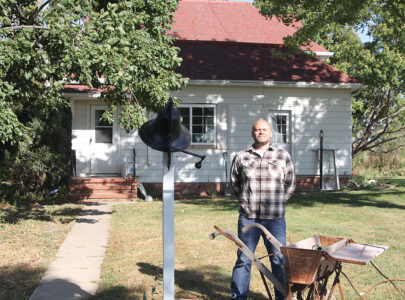Wanda Gág ‘Gone is Gone’ returns home to New Ulm

Wanda Gág House curator Alexander Roth holds up one of the original storyboard drawing created by Wanda Gág for “Gone is Gone.” The drawing depicts the Liesi character heading out to do field work in the morning.
NEW ULM – A new cache of original Wanda Gág art has come home to New Ulm.
Six storyboard drawings for Gág’s 1935 book “Gone is Gone” were recently acquired by The Wanda Gág House Association in New Ulm. The six drawings are each 18 inch by 24 inches and feature a drawing from “Gone is Gone” with handwritten notes on the back. The notes include the text that would later accompany the picture in the completed book.
The six drawings were brought to the Brown County Historical Society museum Tuesday and members of the Wanda Gág House board had the first chance to examine the artwork.
Wanda Gág House curator Alexander Roth believes these drawings were created by Gág to help layout her book. These drawings were likely early drafts of what would ultimately appear in “Gone is Gone.”
“Gone is Gone” is a picture book first published in 1935.

Wanda Gág House board member JoAnne Griebel hold up a copy of “Gone is Gone” to an original storyboard drawing created by Wanda Gág. The storyboard drawing and the final version appearing in the book are very similar, however the the original drawing features subtle revisions made with white ink.
“This is pretty amazing,” Roth said. “I did not expect them to be this size.”
Typically, storyboard drawing for books are drawn in compact sizes to help lay out the book. These storyboards are much larger in size than the final versions appearing in the book.
Roth said what surprised him most was how much the storyboards look like the final drawings appearing in the book. Gág reduced the size of the images for her book, but kept much of the details between the draft.
The storyboards also provides clues about Gág’s revision process. Sections of some of the drawings are covered with white ink, indicating changes and alternations. The storyboards are a great insight into Wanda Gág’s artistic approach, which was unique for the time.
Roth said Wanda Gág was not copying other artists of the time.

A copy of Wanda Gág’s “Gone is Gone” is held up to the original storyboard drawing for the book. The Wanda Gág House Association recently aquired the drawings, which were orginally drawn by Gág in 1934 or 1935. This page depicts a scene in which the character Fritzl ties himself to a cow on the roof to keep it from falling off.
“She did her own thing. You couldn’t pigeonhole her,” he said.
The story of “Gone is Gone” itself was unusual. The book is often cited as an early feminist work.
In the book, the couple, Fritzl and Liesi, both work hard, but Fritzl believes he works harder in the field than Liesi does at home. Liesi disagrees and suggests they switch roles for a day. She goes to work the field while Fritzl prepares a meal. Fritzl soon realizes the house work is not as easy as he believed. Fritzl suffers a series of comedic mishaps and learns Liesi’s work is hard too and vows to never complain again.
Brown County Historical Society Research Librarian Darla Gebhard said “Gone is Gone” is based on folk stories told by German immigrants. Gág specifically heard the story from her grandfather Andreas Biebl
“This is probably her most New Ulm story,” Gebhard said.

Wanda Gág House curator Alexander Roth examines the newly acquired original Wanda Gág prints from her 1935 book “Gone is Gone.”
The six storyboard drawing were brought to New Ulm thanks to the curiosity and research of Beverly Gibson Strozier. She found the drawings while attending an estate sale in Cottonwood, Arizona in July 2007. Strozier is also an artists who creates black and white graphite pieces. She was curious about the drawings. After purchasing the drawings she found a handwritten note on the back of each. It did not take long to connect the drawings with “Gone is Gone” and Wanda Gág.
She eventually contacted Gebhard at the BCHS and together they arranged to bring the pieces to New Ulm.
“Strozier was thrilled to help bring the pieces back to New Ulm,” Gebhard said.
Roth said the book “Gone is Gone” will be the theme for next year, with the new storyboards being a central focus. This is an exciting addition for the Wanda Gág House board.
“We can’t wait to share them,” Wanda Gág House board member Debra Schaefer said. “Makes it feel like a part of her has come home,” Schaefer said.
“It is nicer to have her works closer to New Ulm,” board member LuAnn Lindmeyer said.
- Wanda Gág House curator Alexander Roth holds up one of the original storyboard drawing created by Wanda Gág for “Gone is Gone.” The drawing depicts the Liesi character heading out to do field work in the morning.
- Wanda Gág House board member JoAnne Griebel hold up a copy of “Gone is Gone” to an original storyboard drawing created by Wanda Gág. The storyboard drawing and the final version appearing in the book are very similar, however the the original drawing features subtle revisions made with white ink.
- A copy of Wanda Gág’s “Gone is Gone” is held up to the original storyboard drawing for the book. The Wanda Gág House Association recently aquired the drawings, which were orginally drawn by Gág in 1934 or 1935. This page depicts a scene in which the character Fritzl ties himself to a cow on the roof to keep it from falling off.
- Wanda Gág House curator Alexander Roth examines the newly acquired original Wanda Gág prints from her 1935 book “Gone is Gone.”










